Ecuador, 2012
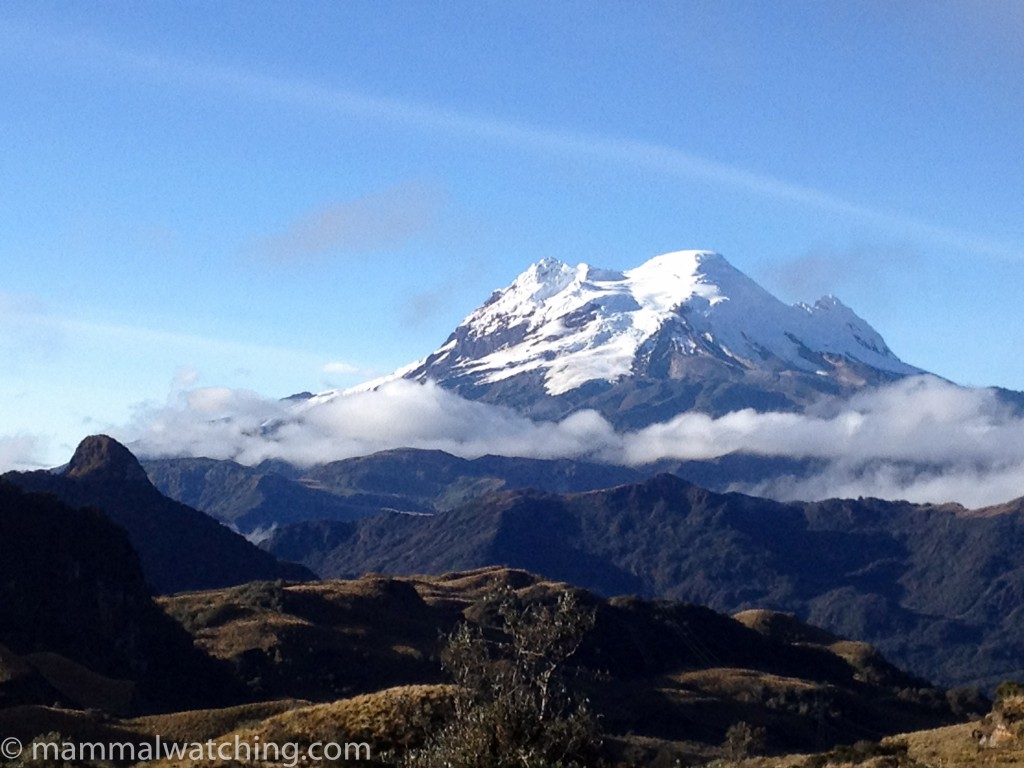
Antisana Volcano, near Papallacta
I first visited Ecuador in August 2012 for a week, drawn by the prospect of seeing Spectacled Bears and Mountain Tapirs in the Andes, topped of with a range of nice primates in the Napo Valley.
Richard Webb, who first told me that Cayembe Coca National Park was a reliable spot for bears gave me some good advice, and I organised the trip through Xavier Muñoz at Neblina Forest. He was well organised and quick to respond, though his expertise is birds more than mammals. My driver, Jose Gallardo was a great guy, hard working and a keen naturalist, which is always useful if you try to persuade someone to go out spotlighting after 12 hours in the field. He’s available to hire privately and I highly recommend him. The brothers Patrizio and Mario Pillajo, guides at Papallacta, were both great, adept at finding the animals and willing to put in as much effort as it took. Gabriel Vado, my guide at Sacha, was also good company and worked hard to look for mammals.
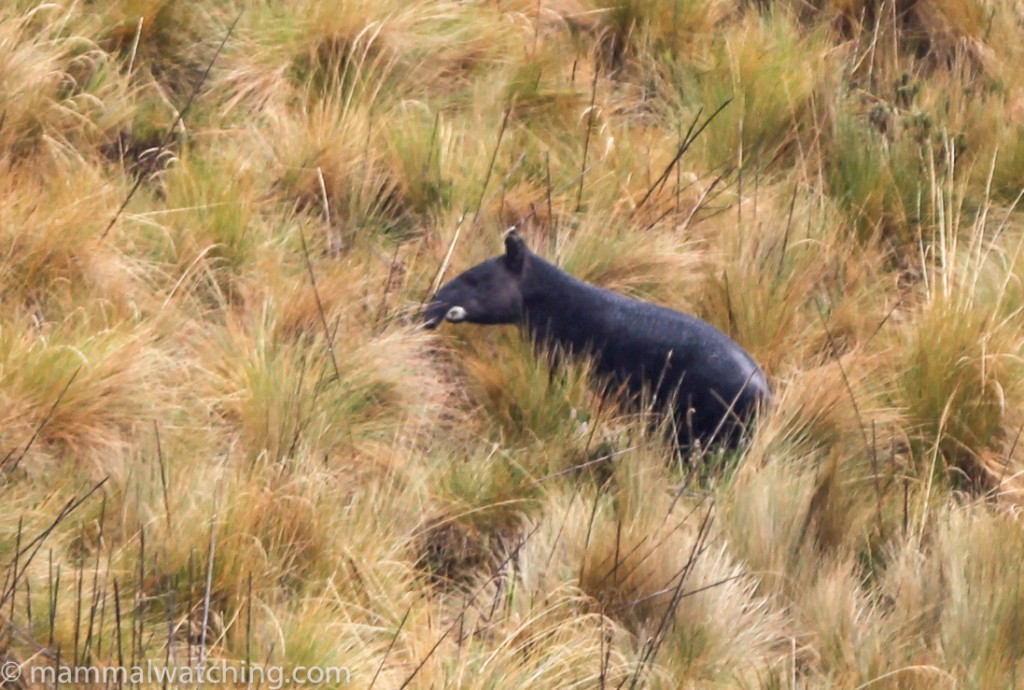
Mountain Tapir, Tapirus pinchaque
A fabulous resource is the website http://www.mamiferosdelecuador.com. This has a full list of all Ecuador’s mammals and – if you search (Buscar) by species – you can get detailed photos of each. Brilliant. If only every country had one of these. Diego Tirira – who I suspect is behind the website – has also written a book Los Mamiferos Del Ecuador which would probably be available in Ecuador. I saw a copy in Wildsumaco Lodge but could not find a way to buy it in the USA other than ordering a copy direct from Diego.
A thunderstorm in Miami delayed my flight to Quito by three hours so I didn’t see much of the city when I got in at 10 p.m. But it looked lovely through the window of the cab. I spent the night at the Hostal Fuente de Piedra, which was fine.
Jose and his Mitsubishi Pajero met me at 6 a.m. on Sunday morning and after a scenic two hour drive we arrived at the small spa town of Papallacta in the Andes, our base for the next three nights.
Cayembe – Coca National Park
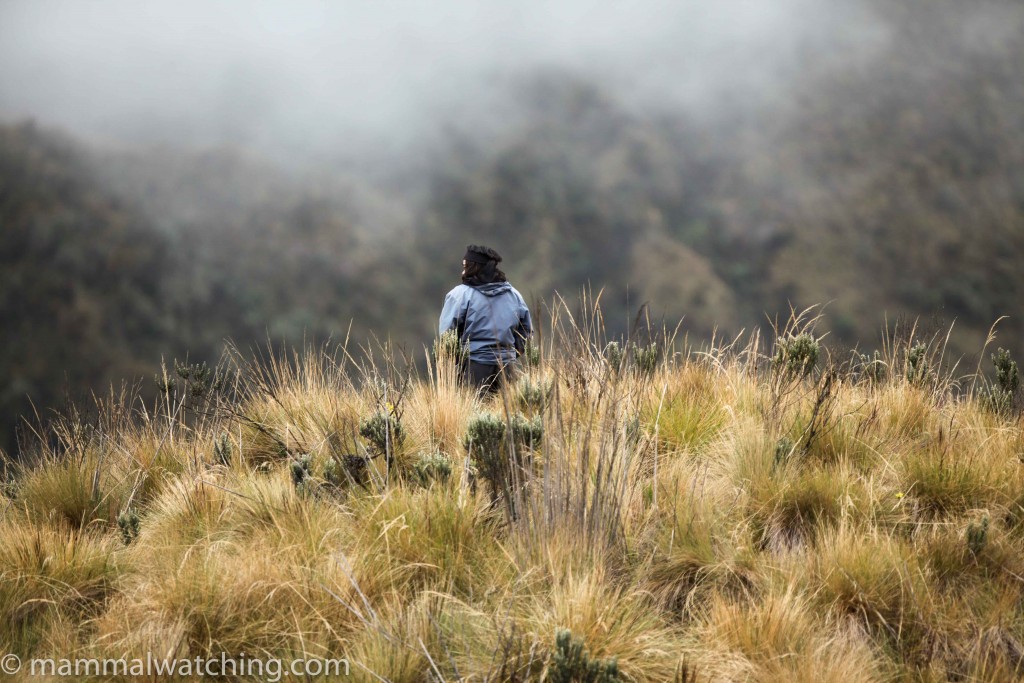
Patrizio, looking for bears across the paramo
Papallacta means “land of the potato”. Perhaps this explains why they feature so often on the menu of the really very nice Termas de Papallacta Hotel, (the nicest and most expensive hotel in town, complete with wifi, hot springs and some killer food). It is also the closest hotel to Cayembe-Coca National Park, the centre of the mammal watching action. There are other hotels a few minutes further away and at probably less than half the price.
After a quick coffee, we met Patrizio, our local guide and also a biologist at Fundación Terra, an NGO set up to protect the park and sponsored by the hotel. Both Richard Webb and Xavier Muñoz recommended Patrizio. Not only is he a good guide, but Patrizio can organise access to the park beforehand, which you need to do: only 36 people a day are allowed into the park if the sign at the gate is to be believed.
A gated road behind the hotel takes you straight into good habitat. Indeed, Richard Webb saw a Mountain Tapir less than a kilometre from the hotel along this road. The park gate proper is 3 kms further up the mountain.
Cayembe – Coca National Park is big, but the area around Papallacta appears to be the best for seeing both Spectacled Bears and Mountain Tapirs (I say appears because a lot of the information in this report relies on conversations I had in Spanish, of which I generally understand 20% and guess the rest).
The park is high – 3500 to 4000 metres – so it is cool, and the altitude is noticeable if like me you are arriving from sea level. It took me a couple of days to adjust. My symptoms were shallow dream-saturated sleep, a headache and a ridiculous amount of puffing and panting after 5 minutes walking up a slope … though I am not sure if the latter was really the altitude.
El Paramo, the park’s ecosystem, is open boggy moorland (known as Pajonal ) with patches of forest clinging to some of the mountain slopes. It is these patches that are the focus of bear and tapir searching. Mammal watching inside the forest would be difficult, amd though the larger mammals use it for shelter they leave it to feed, and so are most often viewed near its edge.
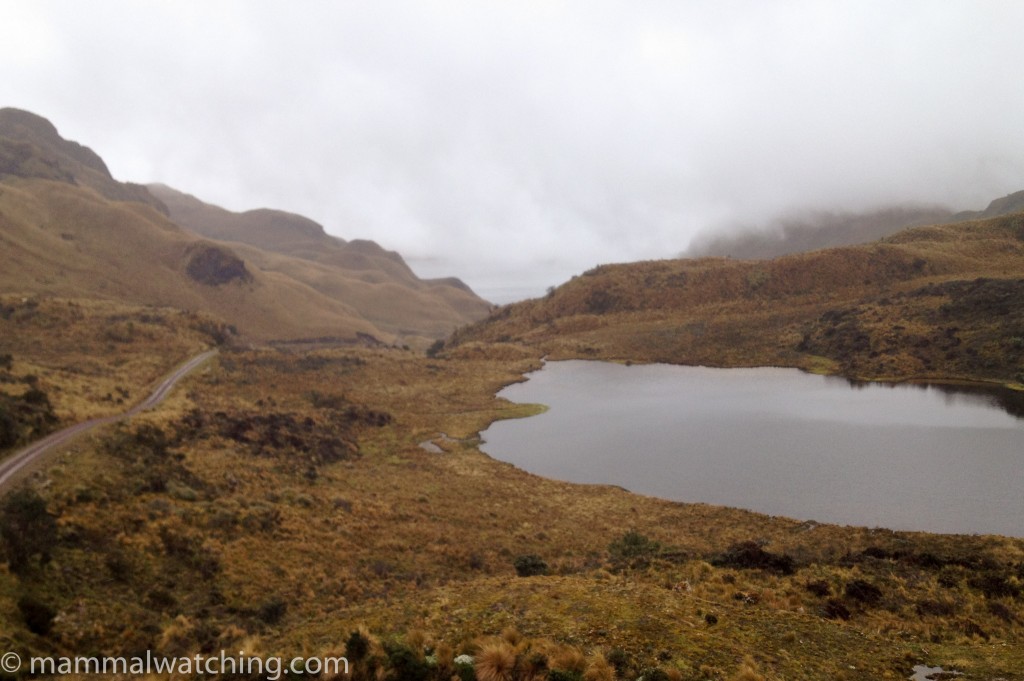
Cayembe – Coca: paramo and panjonal
The next four days were spent driving and trekking around the park. The weather was dreary. The sun was shining when I arrived but two hours later the weather deteriorated and continued to wrosen the whole time I was there. That meant increasing amounts of cloud, and heavier rain showers. Not enough to put the animals off from moving around I imagine, but enough to put me off from looking when the cloud reduced visibility to below 50 metres. It was also miserable wading through the waste deep soaking wet grass. I wished I’d packed waterproof trousers and rubber boots, though Patrizio lent me a pair of the latter.
Patrizio stayed with me for the first day and a half. On the second day he was joined by his younger brother, Mario, who took over for the rest of the trip. I wasn’t sure if either had a plan about the best way to see animals other than by relying on their instinct. But I had faith in their instinct and they knew where to look judging by the amount of animal signs we came across. We used the following strategies for searching: from the car; during short hikes off the road; or during extended hikes of between one to four hours. Our plan of action depended on the weather, which changed frequently.
However we moved around, we paid most attention to the moorland surrounding patches of forest. And an equal amount of attention was given to making rasping raptor-like whistles – sssssseeeuwwww – that imitate the call of the Mountain Tapir. We didn’t hear any respond.
Both tapirs and bears are mainly diurnal it appears. Radio collared tapirs (and I think the bears … my Spanish lets me down again) were most active between 6 – 10 a.m. and 3 – 6 p.m., with almost no activity at night. An excuse to enjoy the wonderful food of the Termas de Papallacta and not go spotlighting.
Day 1
We were inside the park by 9 a.m. and took a three hour walk around the Lagunas los Banos (we started along the trail by the Park entrance gate then went off-piste to the left of the trail after a kilometre). This is meant to be one of the best areas for both bears and tapirs and we heard later that a bear had been seen at 6 a.m. that day. There was evidence of bears and tapirs everywhere: both are messy eaters and leave a lot of evidence, like this bromeliad recently ripped to pieces by a bear.
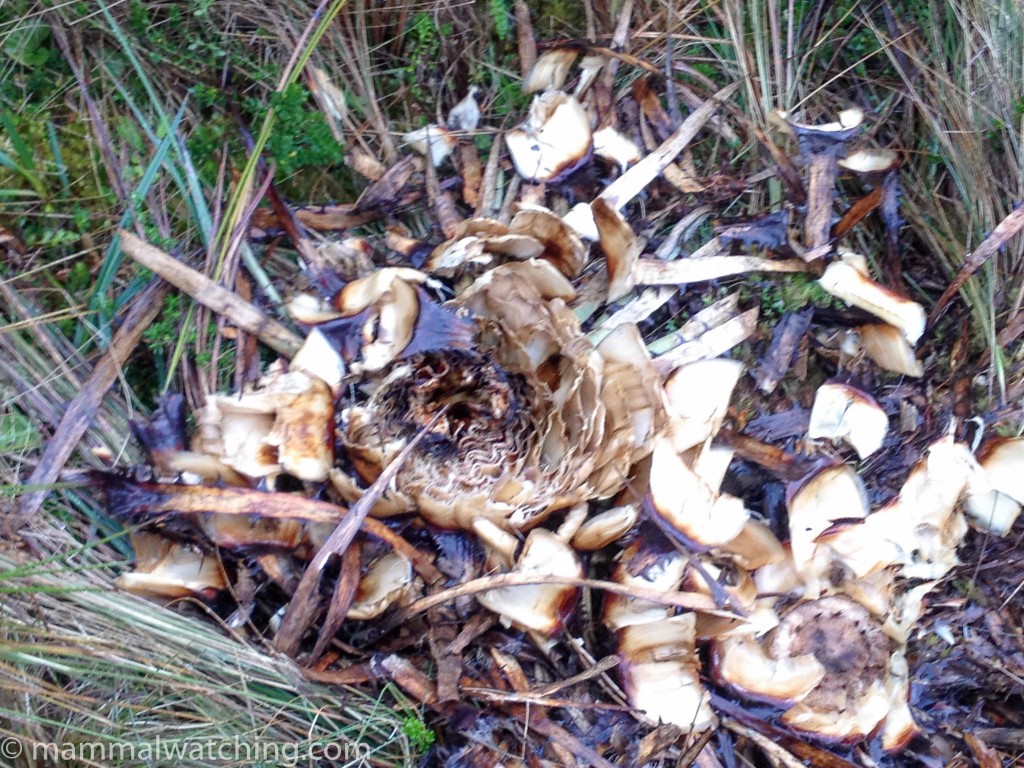
Bear leftovers
Or like this bear scratching post.
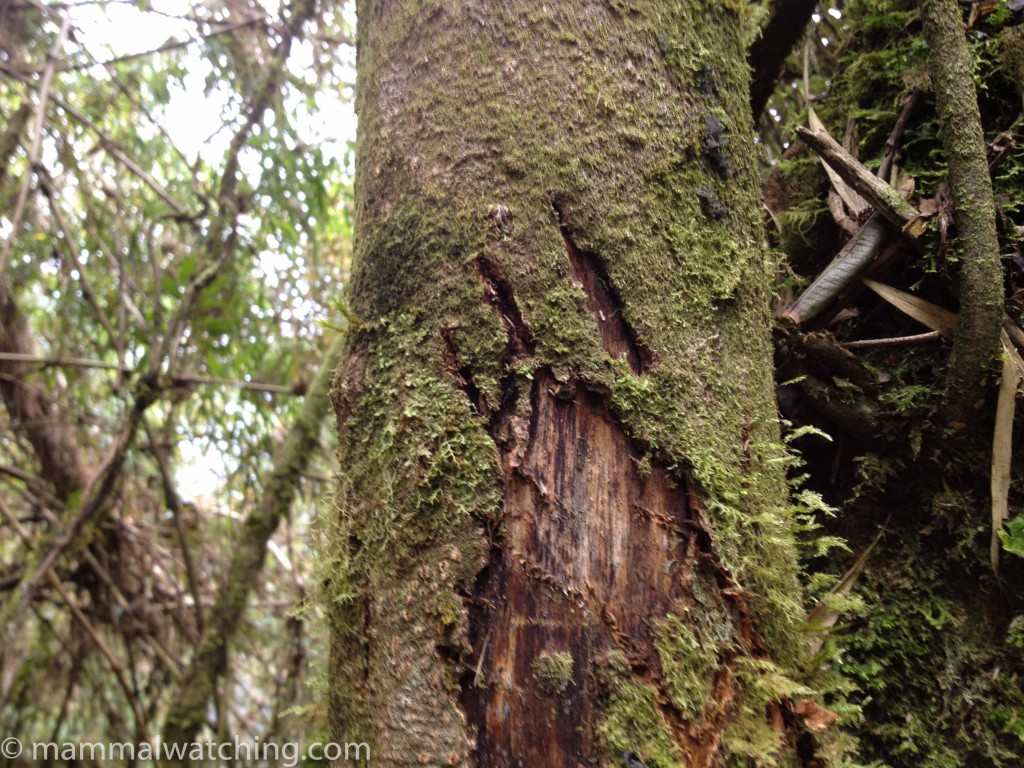
Bear claw marks
After the walk we drove around the park, occasionally leaving the car to walk for a few minutes and look for “something black” moving across the pajonal. The only mammal we saw all day was a lone White-tailed Deer.
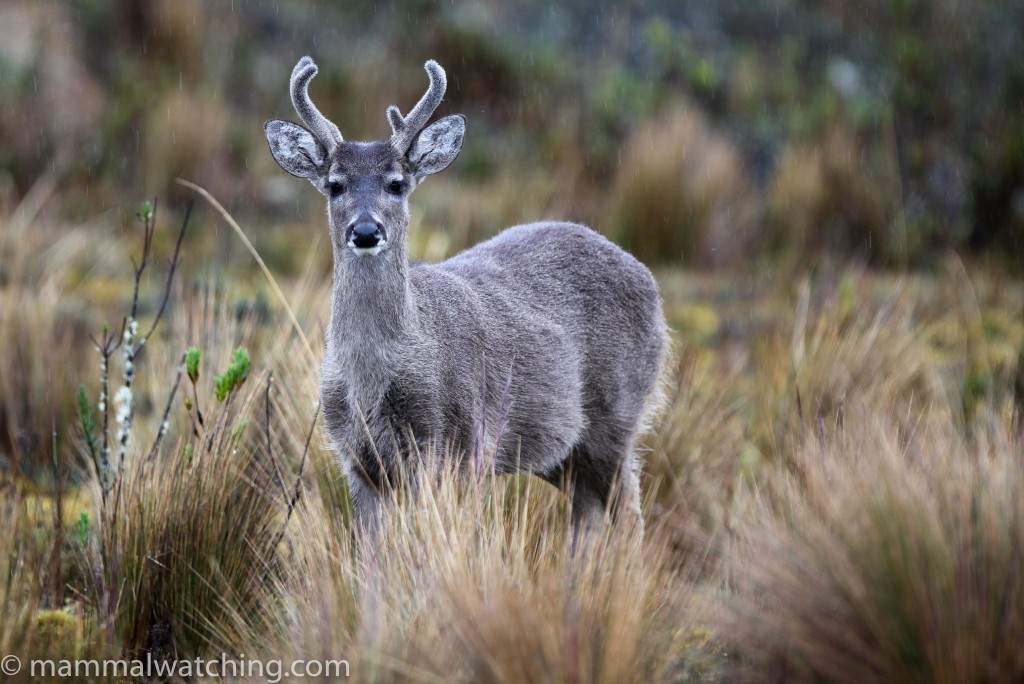
White-tailed Deer, Odocoileus virginianus
Day 2
Poor weather put paid to our planned long walk so we drove around the park, scanning from various locations. We entered at 5 a.m. which was probably a bit over eager as the clouds meant there was no light until gone 6. The only mammals were several groups of White-tailed Deer and some Andean Rabbits (recently split from Brazilian Forest Rabbits) plus cattle illegally grazing in the park. At 11.30 a.n. Patrizio decided we might as well walk for an hour or two across the pajonal, in an area about 20 minutes from the park gate. Within 10 minutes Mario spotted a Spectacled Bear feeding abut 50 metres away. I watched it for 10 minutes, spellbound.
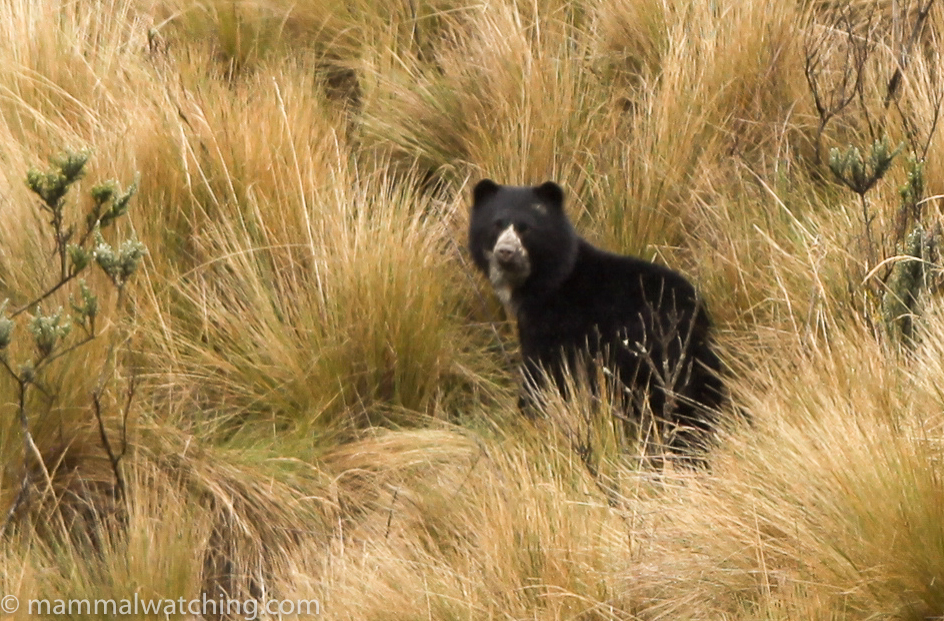
Spectacled Bear, Tremarctos ornatus
So far as I know Cayembe Coca National Park is the best place in the world to see this fabulous mammal.
After lunch at the hotel, we returned to the park, Patrizio returned to his real job and Mario took over the guiding. Tapirs it seemed were going to be harder to see than the bears. And we didn’t see much that afternoon.
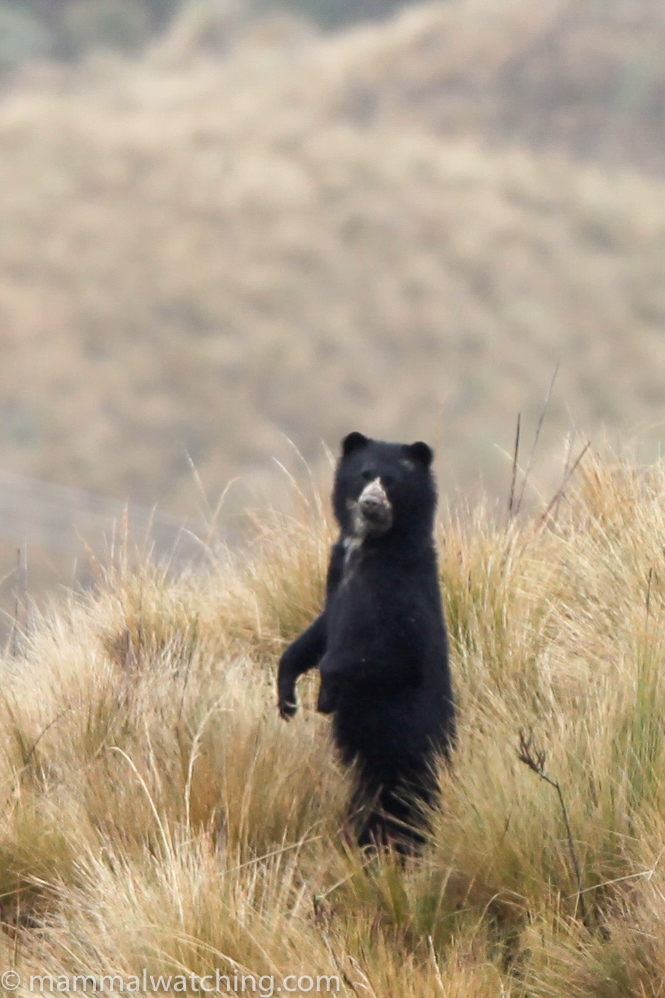
Spectacled Bear, Tremarctos ornatus
Day 3
We drove into the park at 6 a.m. and hiked for a couple of hours and drove some more, all the time focussed on tapirs. The morning’s highlight was an Andean Fox.
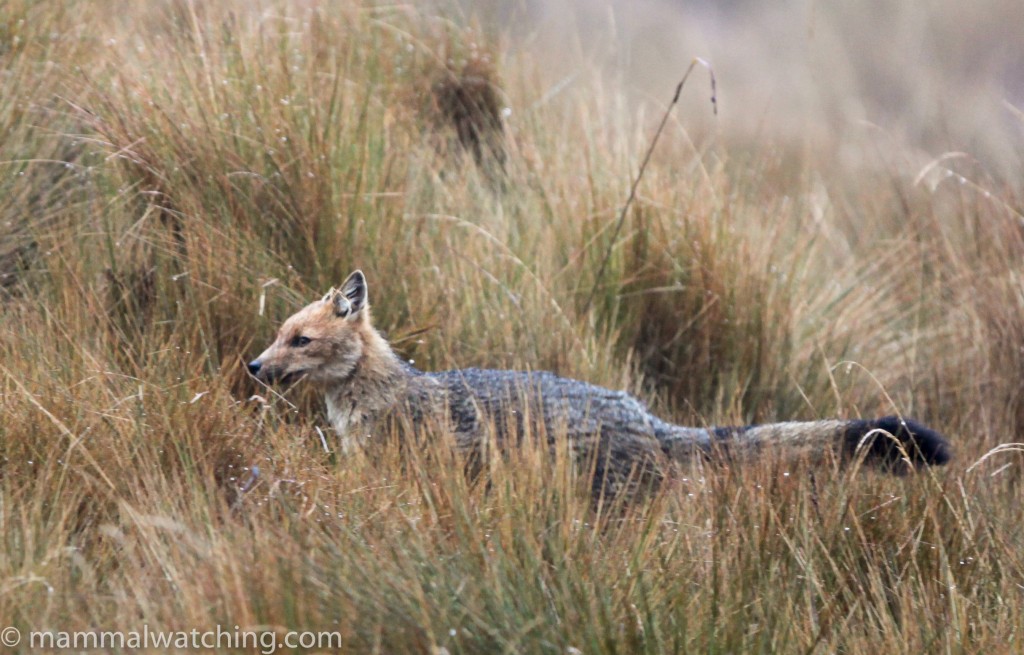
Culpeo (Andean Fox), Pseudalopex culpaeus
After lunch, Mario decided we should try another mountain closer to the hotel. Two teams of biologists – with dogs – had been searching the interior of the park for tapirs for the past two days and not seen an animal. Perhaps, Mario speculated, because a couple of JCBs working on the park roads had spooked the tapirs. So we decided to spend most of the afternoon near the hotel – hiking up a largely overgrown trail to a mountain ridge and then down through the pajonal. The trail leads off of the first road on the left as you are driving into the park from the hotel, though you’d almost certainly need a guide to find and follow it. Once again there was plenty of signs of tapirs and bears but we didn’t see any animals.
Day 4
My last day – or half-day – and the weather was worse than ever. It wasn’t looking good. At 6 a.m. – in an act of tapir desperation – we drove back towards Quito for 30 minutes then walked for an hour through some pajonal in an area reputedly inhabited by tapirs. When the visibility dropped below 50 metres we gave up and went back towards the park, to again hike around the Lagunas los Banos area, where I’d walked during my first morning. After an hour there, in terrible visibility, I gave up and decided to go back to the hotel and pack.
Back at the car we met Armando Castellanos, an Ecuadorean biologist, and the head (I think) of the group looking for a tapir with a defective radio collar (the same group that had been looking for several days and not seen an animal). He’d found fresh tracks late yesterday and when the weather cleared was going back to the same area, this time with two dogs and a local assistant, Melchor Ascanta, a skilled tapir tracker. Armando was generous enough to invite me along for the ride. What a star! I doubt whether many biologists would bother with the hassles of taking a tourist along when they were trying to tranquilize an animal that they had spent days looking for. Armando has two nice videos of Tapirs up on youtube. Here and here.
My optimism refreshed, half an hour later I was hiking up another mountain and then down a very steep creek line. Lots of tapir signs but no fresh scent. After an hour, in the rain, my optimism began to wain again. The trail had gone cold and Armando decided to continue to walk down and around the mountain. I decided to leave, resolving to return here, or maybe take a trip one day to Sangay Volcano NP where Armando said the tapirs were much easier to see ( a trip that would involve hiring three horses for the two day ride into the park: fun, but time consuming).
After 15 minutes steep climb back toward the car I heard a whistle. The tracker had spotted a tapir. I was back down the creek line faster than a Parisienne into a seat on the metro. And 20 minutes later I was looking at my first Mountain Tapir. Or at least the head of one. Later Armando crossed over the small valley between us and the Tapir and flushed it into the open.
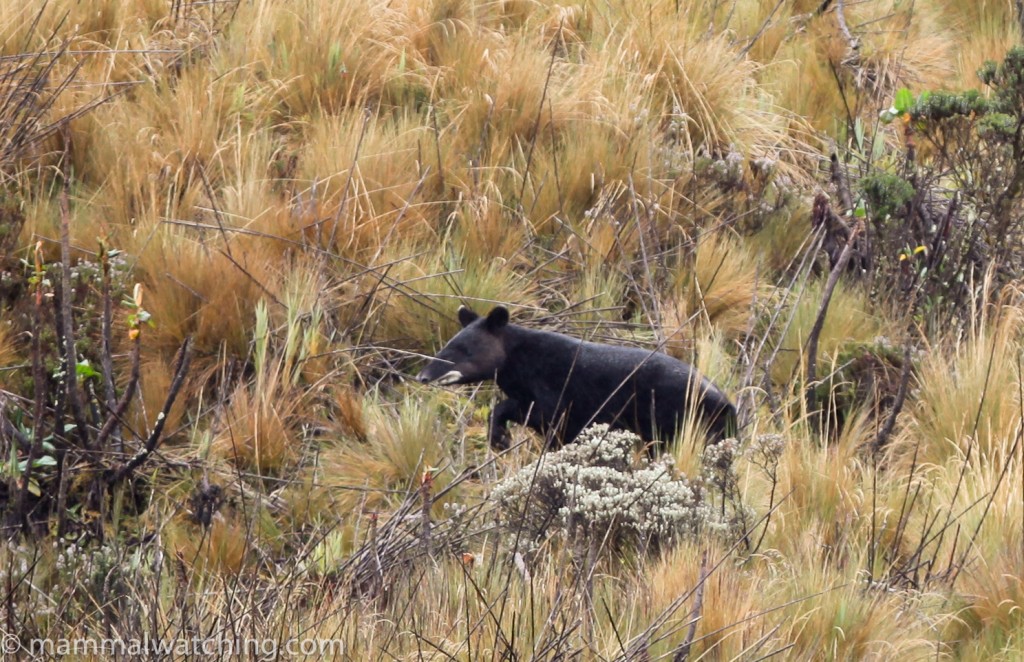
Mountain Tapir, Tapirus pinchaque
A beautiful animal – my favourite of the 4 species (all of which I’d now seen) – with its glossy black pelt and white lips. And this, coupled with all the effort involved and last minute brinkmanship, makes it one of my favourite ever mammal encounters. If I’d left the park five minutes earlier I would not have met the biologist… if I’d left the biologist 5 minutes earlier I would not have heard the “I’ve seen a tapir” whistle. Yay!
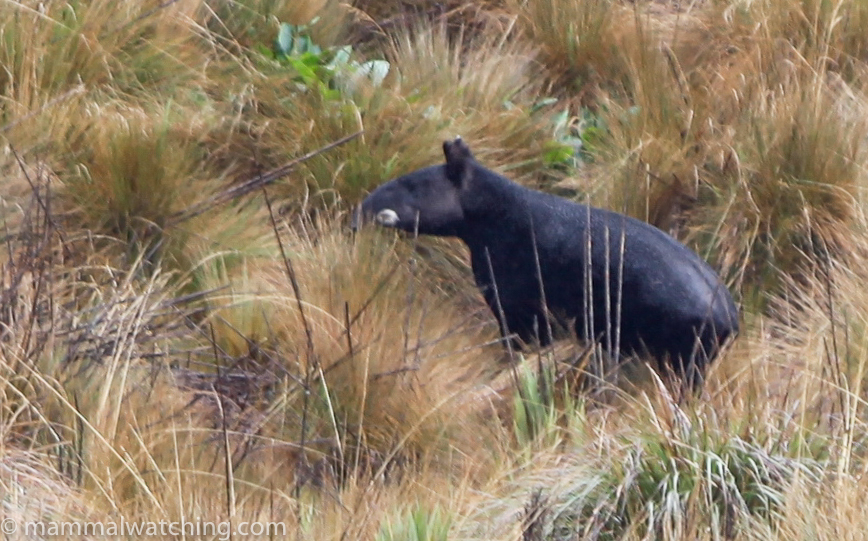
Mountain Tapir, Tapirus pinchaque
Elated with the tapir I hoofed it back to the hotel for a shower and lunch and then Jose drove the three hours to Wildsumaco Lodge, a half way point en route to the Napo Valley.
Wildsumaco Lodge
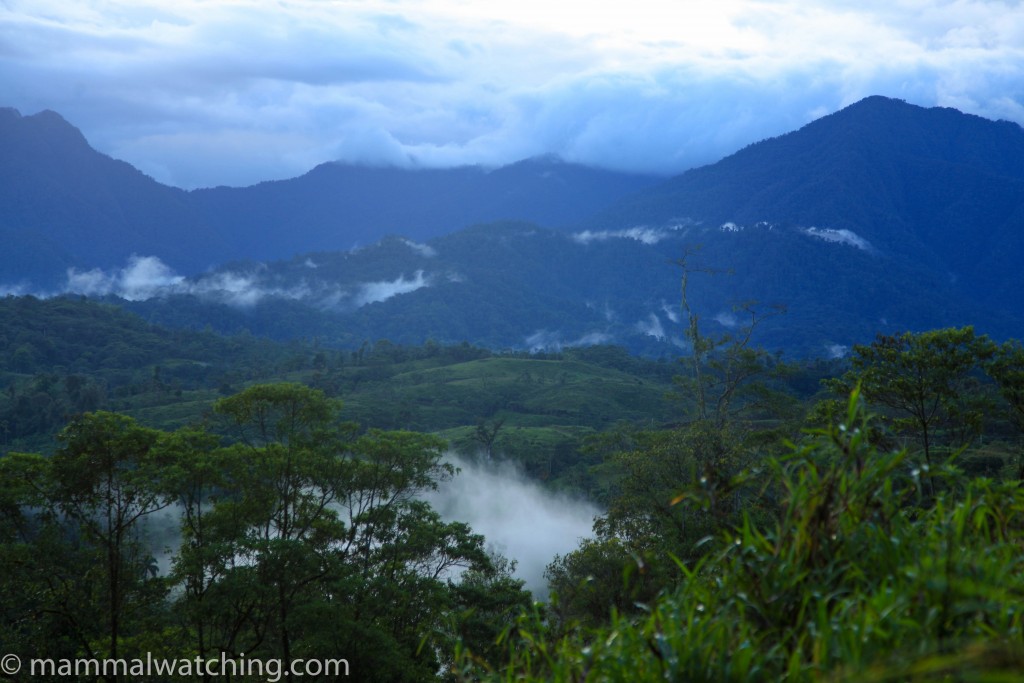
Cloud forest, circa 1500 metres above sea level
Wildsumaco Lodge is a nice place to break the journey between Quito/Papallacta and Coca, the jumping off point for the Napo Valley. Primarily a birding lodge, the owners were interested in mammals and had recorded some cool species mainly through camera traps, and Margays are not uncommon it seems. Visit their website for more details.
We arrived after dark and other than a squashed Striped Hog-nosed Skunk on the highway about 10 kms before Sumaco, and some more Tapitis (though these may be split in future) on the rough drive into the lodge, we saw no mammals. An hour’s spotlighting after dinner produced what seems likely to have been a Bicoloured Arboreal Rice Rat (Oecomys bicolor) though I would need to have had it in the hand to be certain.
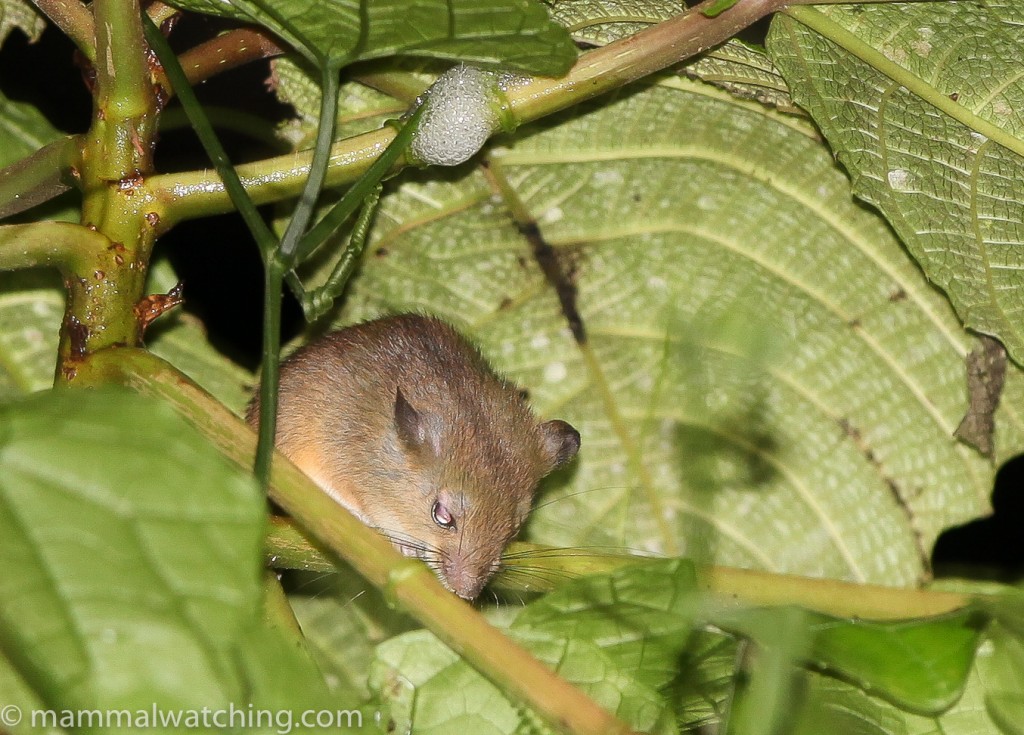
Bicolored Arboreal Rice Rat, Oecomys bicolor
Day 5
In the morning I was flicking through the lodge’s Mamiferos del Ecuador book (by Diego Tirira and worth getting if you can find it – probably most likely in Quito though the author can also sell you a copy): this book records the Black-mantled Tamarins in this area as the newly split Graell’s Tamarin (Sanguinus graellsi). The IUCN does not list them as a separate species though at the moment so I have put them down here as S. nigricollis graellsi for the moment. They were reasonably common around the lodge but unpredictable. I figured the best way to find one would be to drive slowly along the road out of the lodge on the way to Coca.
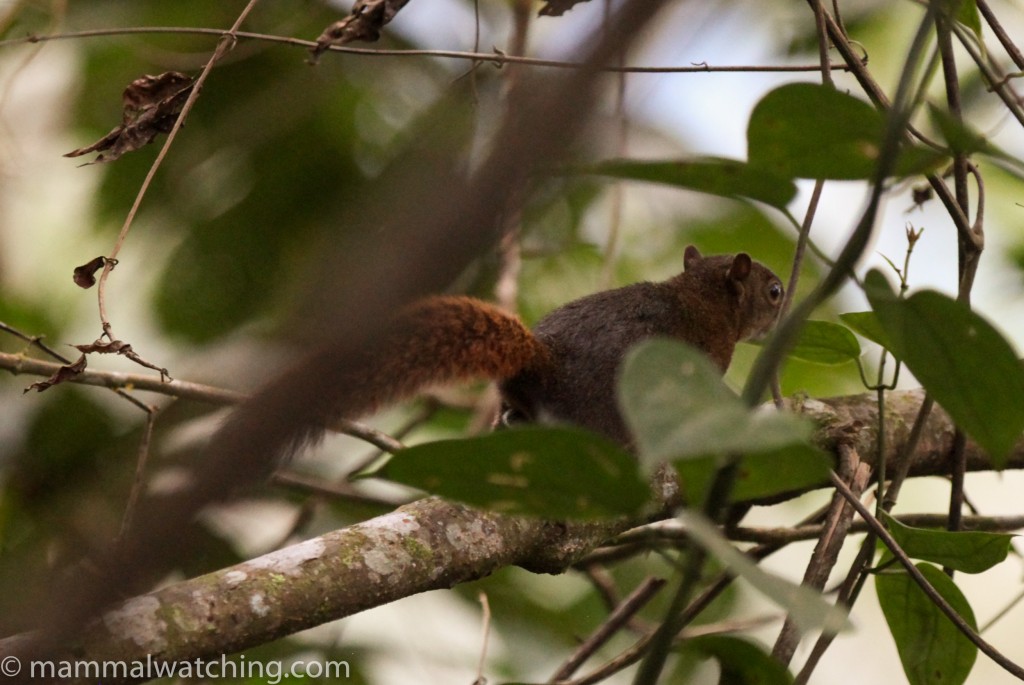
Red-tailed Squirrel, Sciurus granatensis
After breakfast we had prolonged views of a Red-tailed Squirrel in the garden before setting off at 8 a.m. And about 3km down the road I spotted a couple of Graell’s Tamarins, hard to photograph against the sun.
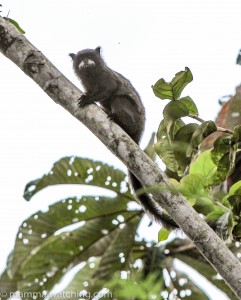
Graell’s (Black-mantled) Tamarin
Two hours later I was in the town of Coca, waiting for the boat to Sacha Lodge – a wait that ended up being over 2 hours following some confusion about what time the boat left. But by 1 p.m. I was on a motor-canoe, buzzing along the Napo River for the 50 mile and 1.5 hour ride. After tieing up our canoe, we had to walk 20 minutes along a trail and take a 10 minute paddle across a blackwater lake to reach the lodge itself.
The Napo Valley
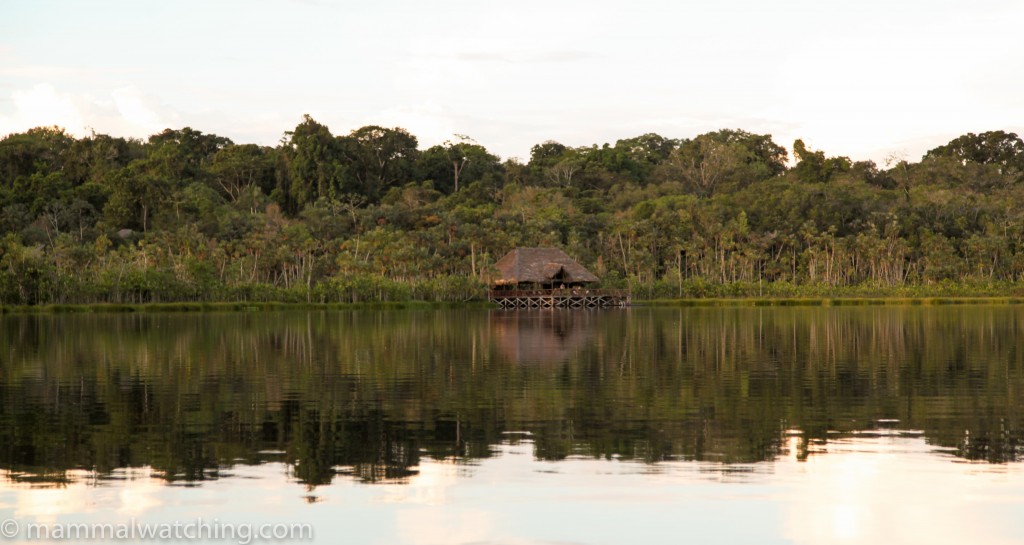
Sacha Lodge
I had thought initially that I would stay at the Napo Wildlife Centre. But they were full. Other – more expensive – lodges had space including Sacha and Sani. Xavier at Nebulina did not shed much light on the differences, and I opted for Sacha mainly because of Rich Lindie’s excellent notes on the mammal watching there. Rich’s notes remain quite accurate, though the Green Agouchis seem much less common than they were in his time.
We arrived at 3.30 p.m. and I was introduced to Gabriel, my guide. I paid extra to have a private guide which I think you’d have to do if you wanted to focus on mammal watching. Most of the other guests seemed only moderately interested in nature, other than some serious birders, though any mammals the birders saw would be treated as by-catch.
At 3.45 p.m it started pouring with rain so the rest of the afternoon was a write off. After dinner, Gabriel and I did some half –hearted spotlighting – the rain had stopped – and we heard what were probably a Night Monkey and a Nine-banded Armadillo, though I didn’t see either. We did see the infamous Bullet Ants and a Blunt-headed Snake. Gabriel was not optimistic about spotlighting: in a year working at the lodge he claimed never to have seen an opossum, nor any cats. He had, however, seen a Giant Armadillo not long after he started working there. Pacas were not uncommon at night and another group saw one that same evening. I suspect he had done much less spotlighting than Rich Lindie would have done over the same period.
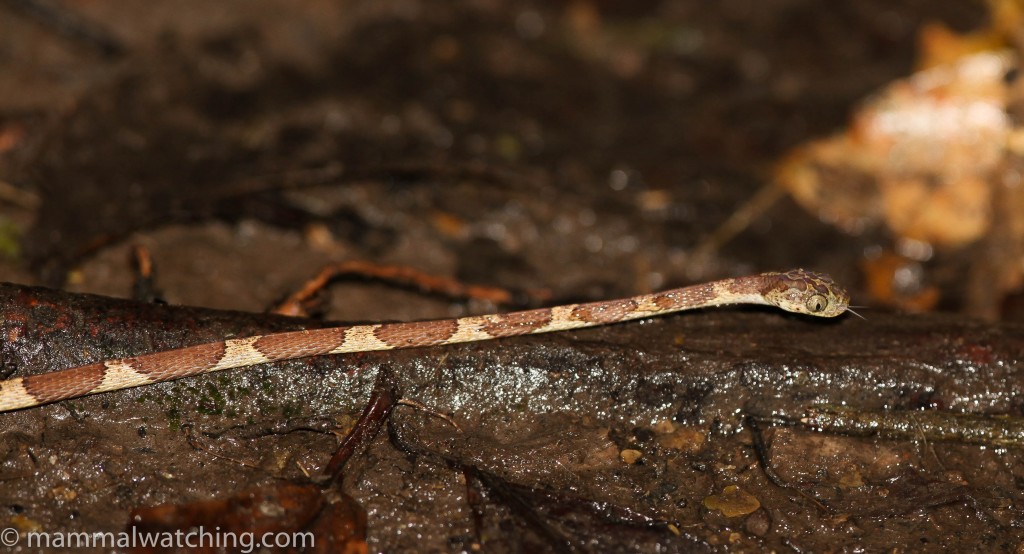
Blunt-headed Snake
Day 6
At 6.45 a.m – after breakfast and before heading out on a canoe – I saw my first Pygmy Marmoset, in their regular spot outside of cabin no. 5. One of my priorities for the Napo and a species I had heard in Palmari Lodge but not seen.
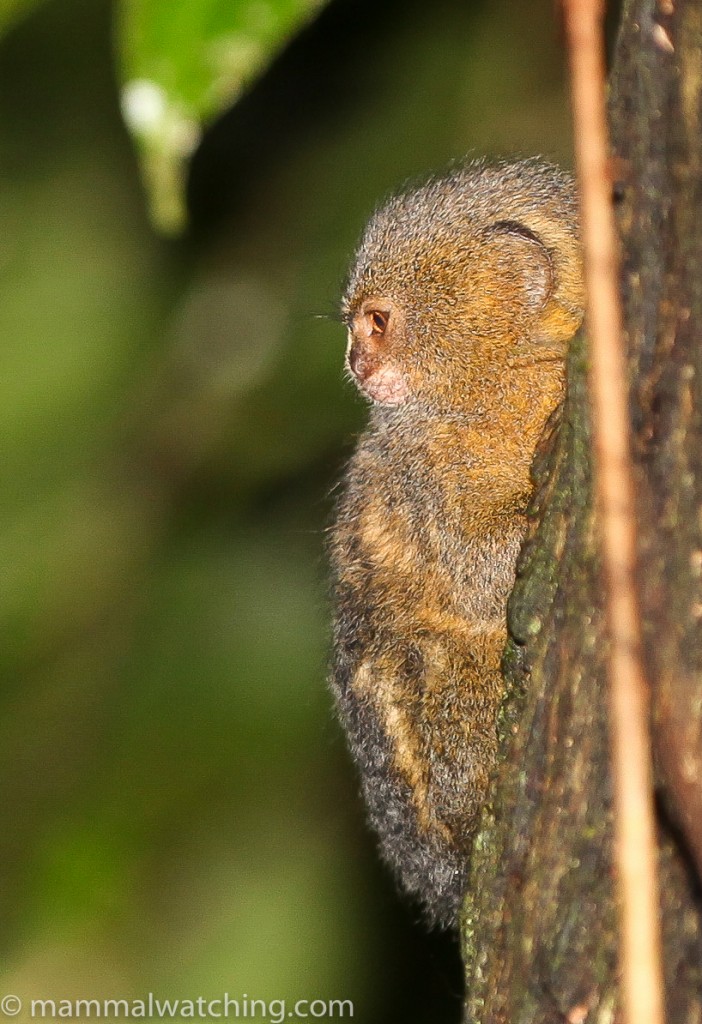
Pygmy Marmoset, Callithrix pygmaea
The remaining two targets for the morning were Marañó White-fronted Capuchins (a recent split) and Spix’s Night Monkey. The former are best found in flooded forest, the latter in one of their regular roosting holes. During a 30 minute paddle down a creek the only mammals were a Red Howler Monkey, which the local guide Jaime spotted but which dissolved into the canopy before I could see them, and some Graell’s Tamarins (a subspecies of Black-mantled Tamarins not found on the southern side of the Napo River). We left the canoe at the end of the creek and walked a trail back to the lodge. We must have visited 10 roosting sites for night monkeys before we finally saw an animal.
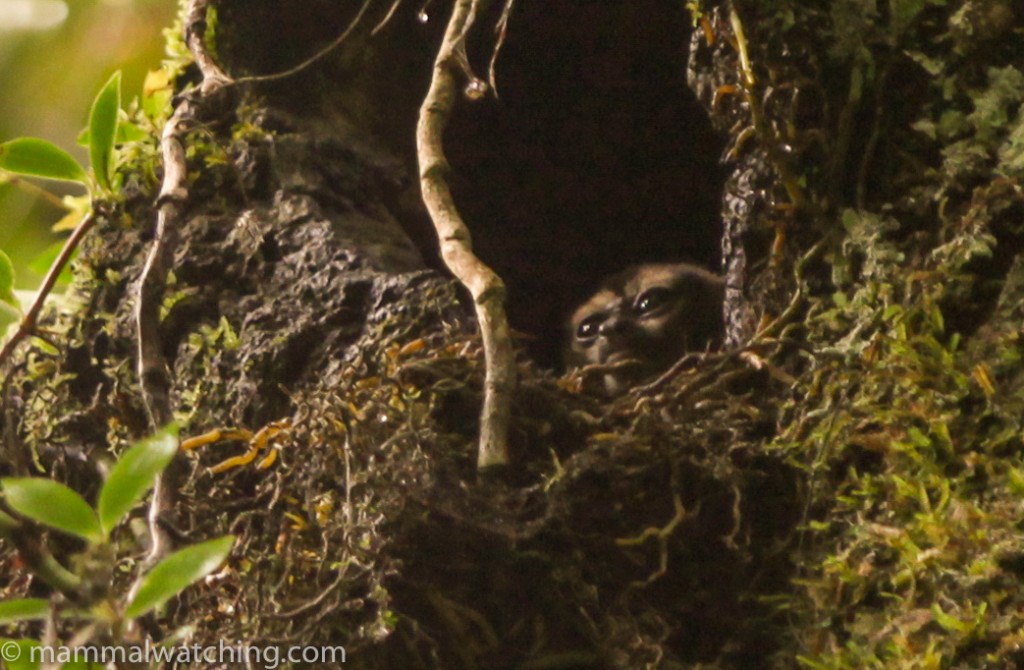
Spix’s Night Monkey, Aotus vociferans
We also found a couple of Greater White-lined Bats around the roots of a giant Kapok tree. This is a usual haunt for this species at Sacha.
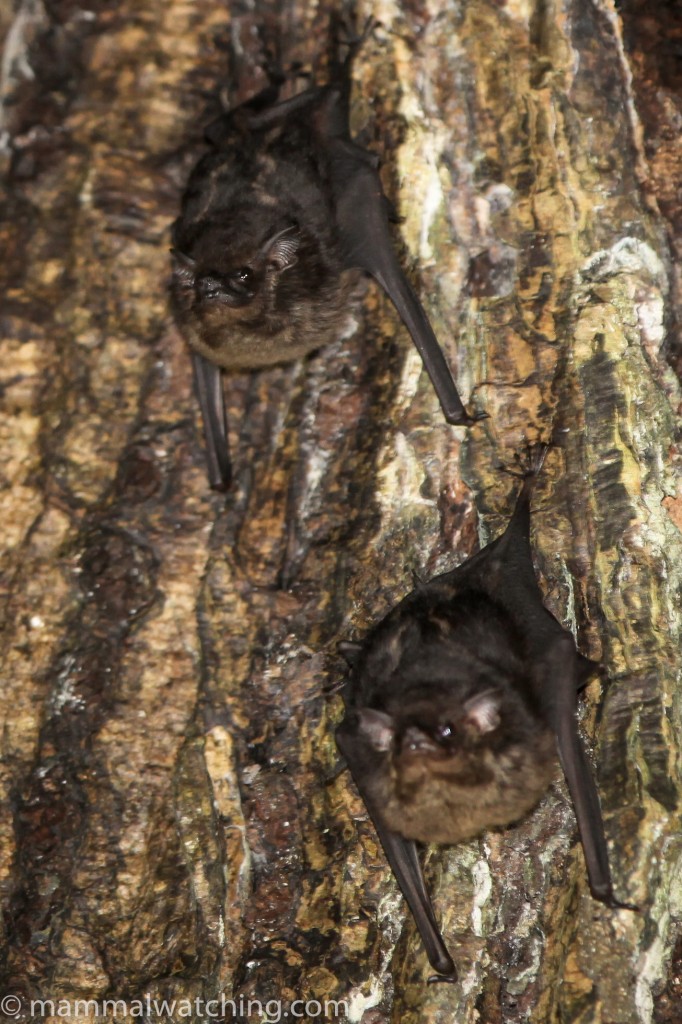
Greater White-lined Bat, Saccopteryx bilineata
The paddle back to the lodge was very quiet but as we entered the lake, and were discussing whether to try another creek for the capuchins, Jaime spotted a lone White-fronted Capuchin in a tree at the water’s edge. This species is now split from Cebus albifrons.
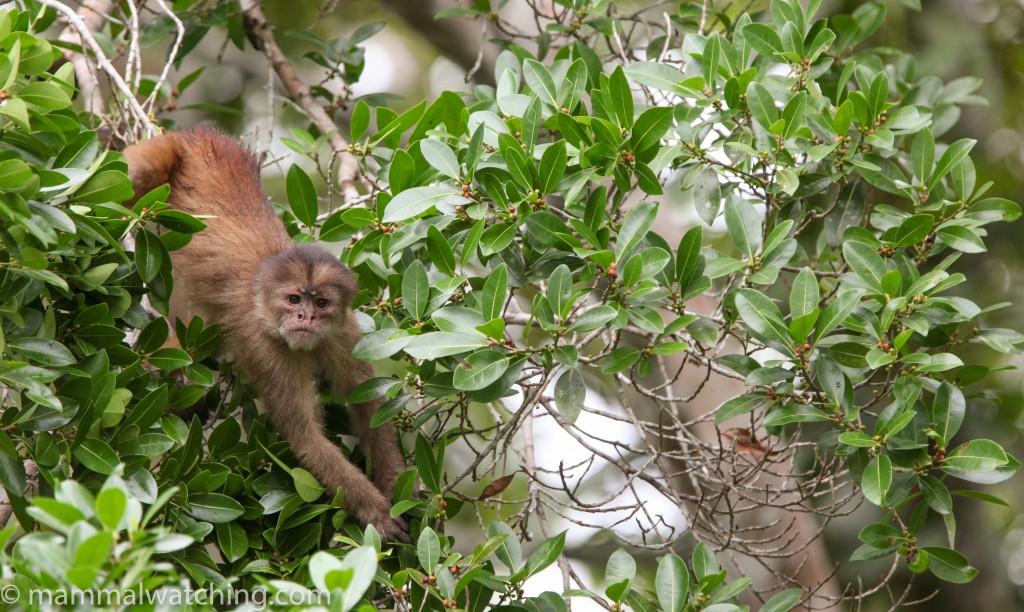
Marano White-fronted Capuchin, Cebus yuracus
I photographed a large troop of Common Squirrel Monkeys at the lodge and then had 90 minutes to kill before lunch. Rain meant I spent it in my hammock rather than looking for Green Agouchis.
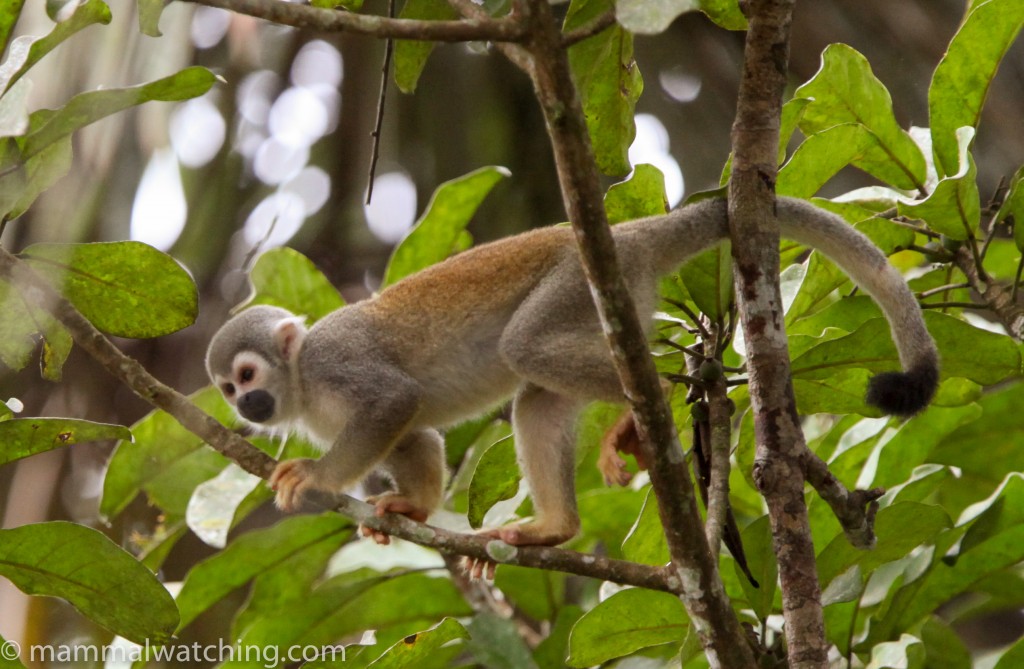
Common Squirrel Monkey, Saimiri sciureus
In a year at the lodge, Gabriel had seen titi monkeys twice. Somebody – and I cannot remember who – told me the titis at Sacha were Callicebus lucifer (the Lucifer or Yellow-handed Titi) and different to the Red Titi (Callicebus discolor) on the other side of the river. But all other information I have read contradicts this and in fact I think there are Red Titis on both sides of the river.
Gabriel thought they were rare. But following Rich Lindie’s notes we headed into the secondary forest nearer to the main river and found a group within an hour. They were too shy to pose for photos but I got some (bad) pictures the next day. We also saw Red Howlers, and more Common Squirrel Monkeys and capuchins. There were fresh Tapir tracks here too.
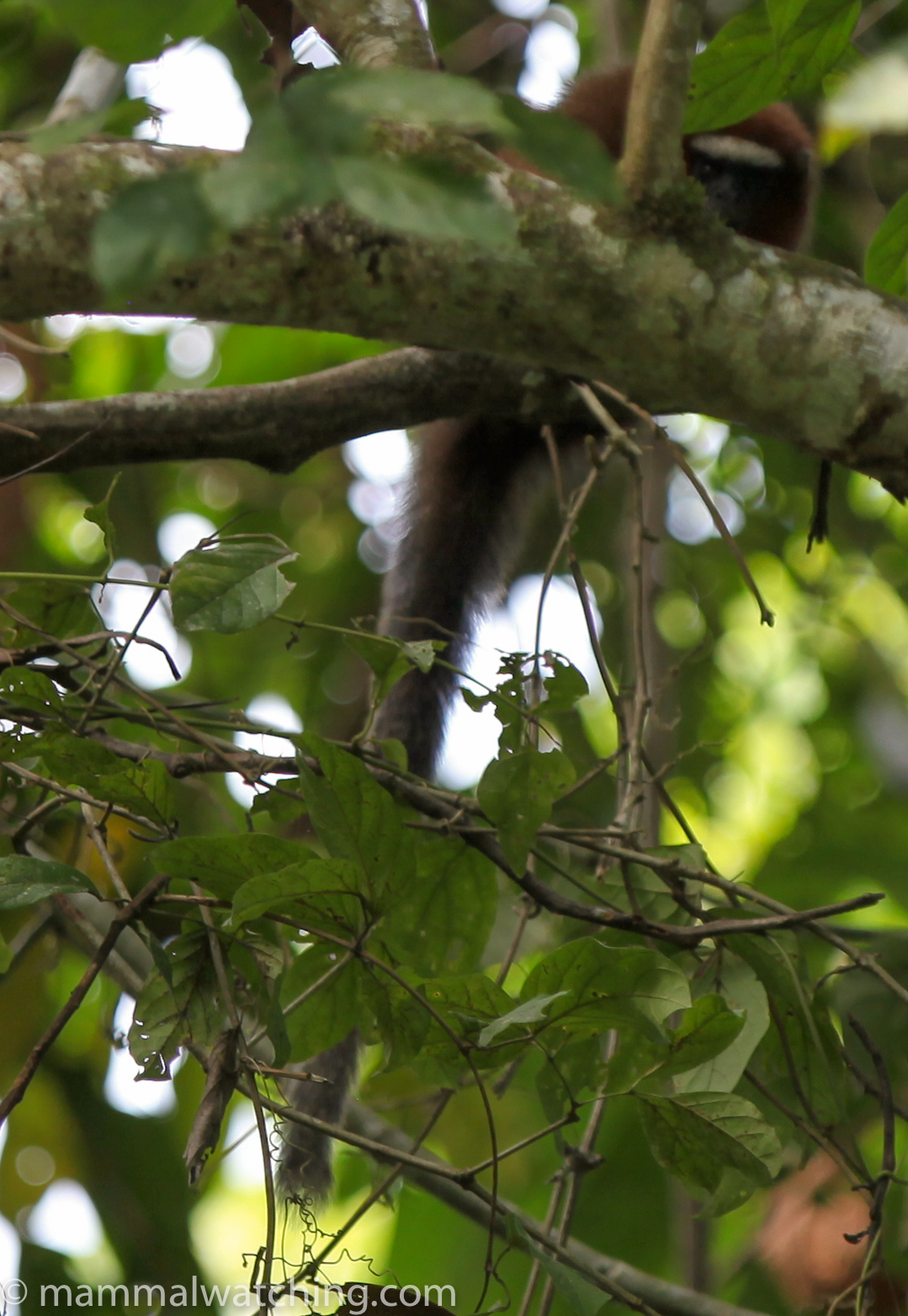
Skulking Red Titi, Callicebus discolor
I didn’t spotlight that night.
Day 7
I’d seen all the Sacha Lodge primates during my first day, so on my second (and last day) I needed to cross the river to look for Golden-mantled Tamarins (which only occur on the south side) as well as Equatorial Sakis, Silvery Woolly Monkeys and White-bellied Spider Monkeys. There were decent chances for the first two species I’d been told, and a not too distant chance for the Woolly Monkeys as well. The Spider Monkeys were much harder.
We had breakfast at 5 a.m. and walked back to the Sacha staging post on the Napo and took a launch across to the other side, to an area of Yasuni National Park called “Nuevo Provencia”. Gabriel reckoned it could be good for both the tamarins and woolly monkeys, and thought both species had been seen there before. The guides know much less about the south side of the river though: this was Gabriel’s first visit, and I don’t think Jaime had been more than once or twice either. We walked for 3 hours and Gabriel thought he head the Tamarins several times, but we couldn’t get a look at them. We did however see several groups of Red Titis.
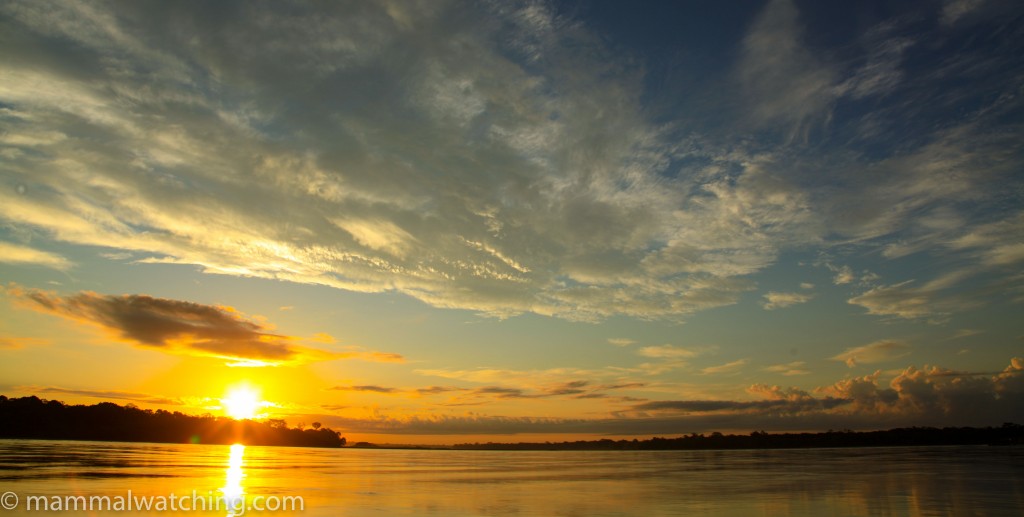
Dawn on the Napo River
When we got back to the boat at 10 a.m. two massive canoes had arrived from Coca carrying about 80 tourists. We left, and headed for another part of Yasuni National Park half an hour down river. Gabriel had never been here either and neither it seems had Jaime. We walked for 90 minutes along a steadily deteriorating trail – I slipped down a couple of steep muddy slopes – and then lost the path altogether, so we had to retrace our steps. We had heard a couple of groups of monkeys on the way but couldn’t get onto them. On the way back I got the briefest of glimpses of a Napo (Monk) Saki Monkey (flying across my binocular field of view – not tickable). I heard several others.
After lunch and a siesta we took a smaller motorised canoe up a side river into the Provencia section of Yasuni National Park. It was a beautiful creek but we couldn’t turn the engine off for more than one minute at a time which detracted from the peace. We spotted one group of Red Titi Monkeys but no sakis or tamarins. We got back to the lodge by 5.30 p.m after 12 unproductive hours.
Day 8
On my last morning I had to leave for Coca at 10.30 a.m. At dawn Gabriel, Jaime and I were returning back across the river to Nuevo Provencia, to try again for the Golden-mantled Tamarins. We took a motor canoe further up the creek into Provencia that we’d ventured yesterday. We heard more titis and got very close to tamarins but again couldn’t see them.
At 8 a.m. we walked the trail again in Provencia and this time saw two or three groups of the glorious Golden-mantled Tamarins. They were too skittish to photograph but I got good – if brief – views. Mission successful: this is a key species for the Napo as it has a rather restricted distribution.
From there to Coca and Quito, and a flight back to New York the next day.
Final Thoughts
A quite successful week: I saw the species I was most looking for, and racked up 11 new species overall. While I was quite lucky to see both Spectacled Bears and Mountain Tapirs in a short stay, it was not without considerable effort. And I was maybe a bit unlucky not to bump into anything more unexpected, like a Tayra or a Southern Two-toed Sloth, both of which had been seen recently in Sacha. Although Sacha Lodge is quite good, I think the Napo Wildlife Centre (NWC) would be a better bet for mammal watching: I would probably have seen Spider Monkeys there too, as well as other stuff such as Giant Otters (which I wasn’t looking for on this trip). The Graell’s (Black-mantled) Tamarins are not at NWC but you could see these at Sumaco for instance.
August probably isn’t the best time to visit Ecuador: the weather in the mountains will be better during December through March, and the Napo would be drier too in that season. That said, the Napo would also be hotter: it was pleasantly cool in August.
Ecuador is a lovely country. And I will go back. Next time I might try Cuyavena National Park, where it seems Amazonian Manatees are a possibility (Gabriel saw one here), and head deeper into the Napo Valley to try Shiripuno Lodge, where this is a good chance for both Silvery Woolly Monkeys, White-bellied Spider Monkeys and perhaps some of the cats or even a Giant Armadillo. I see they are planning to offer a “mammal” tour soon 🙂
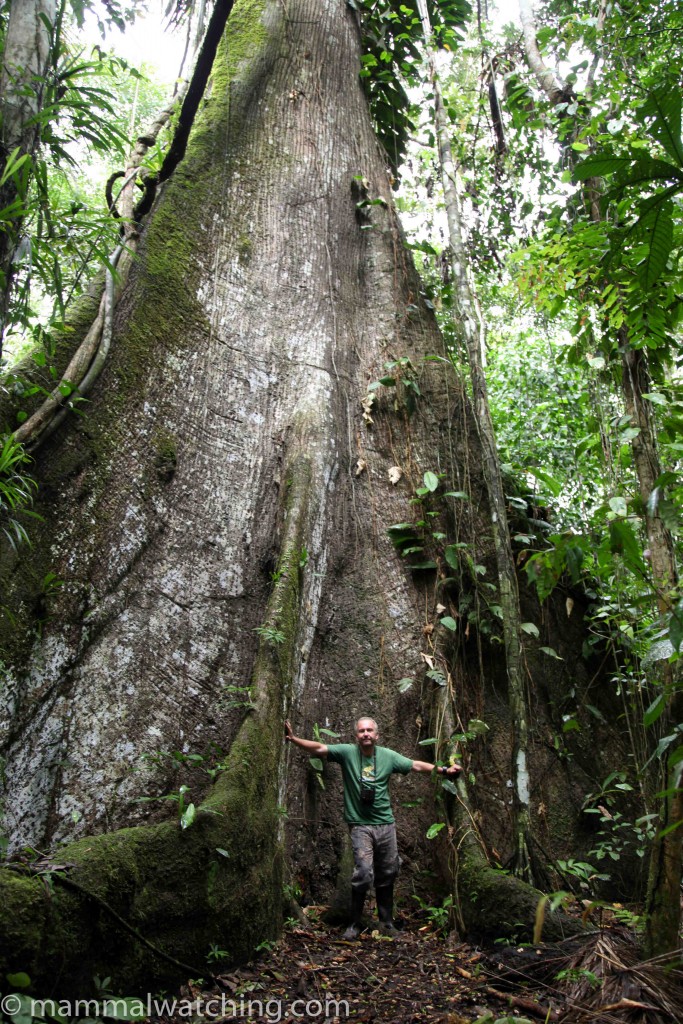
Kapok Tree at Sacha Lodge
Stuff I Missed
Not a great deal really. In the Andes I had half an eye out for a Long-tailed Weasel, or for the Dwarf Brocket Deer that Richard Webb reported, but they aren’t common and I was too focussed on looking for tapirs and bears to look especially for them. In the Napo I missed a Two-toed Sloth by a couple of days, and a Tayra was also reported while I was there. Silvery Woolly Monkeys were more predictable there, but still not easy. Spider Monkeys seem very hard to see anywhere but the Napo Wildlife Centre. As always in the Amazon, my small mammal trapping was utterly useless (I put traps out for three nights). I must change my technique or bait!
Trip List
Lifers are in bold
1. Andean Rabbit Sylvilagus andinus
2. Forest Rabbit (Tapiti) Sylvilagus brasiliensis
3. Red Tailed Squirrel Sciurus granatensis
4. Bicoloured Arboreal Rice Rat Oecomys bicolor
5. Greater White-lined Bat Saccopteryx bilineata
6. Culpeo Pseudalopex culpaeus
7. Spectacled Bear (Andean Bear) Tremarctos ornatus
<Striped Hog-nosed Skunk Conepatus semistriatus – dead>
8. Graells’ Black-mantled Tamarin Leontocebus nigricollis graellsi
9. Golden-mantled Tamarin Leontocebus tripartitus
10. Pygmy Marmoset Callithrix pygmaea
11. Common Squirrel Monkey Saimiri sciureus
12. Marañó White-fronted Capuchin Cebus yuracus
13. Noisy (Spix’s) Night Monkey Aotus vociferans
14. Red (Double-browed) Titi Callicebus discolor
15. Monk (Napo) Saki Pithecia monachus (napensis)
16. Venezuelan Red Howler Monkey Alouatta seniculus
17. White-tailed Deer Odocoileus virginianus
18. Mountain Tapir Tapirus pinchaque
1 Comment
Leave a Reply
You must be logged in to post a comment.


Craig Downer
Excellent observations and photos! Congratulations! Makes me miss Ecuador and the Mountain Tapirs!